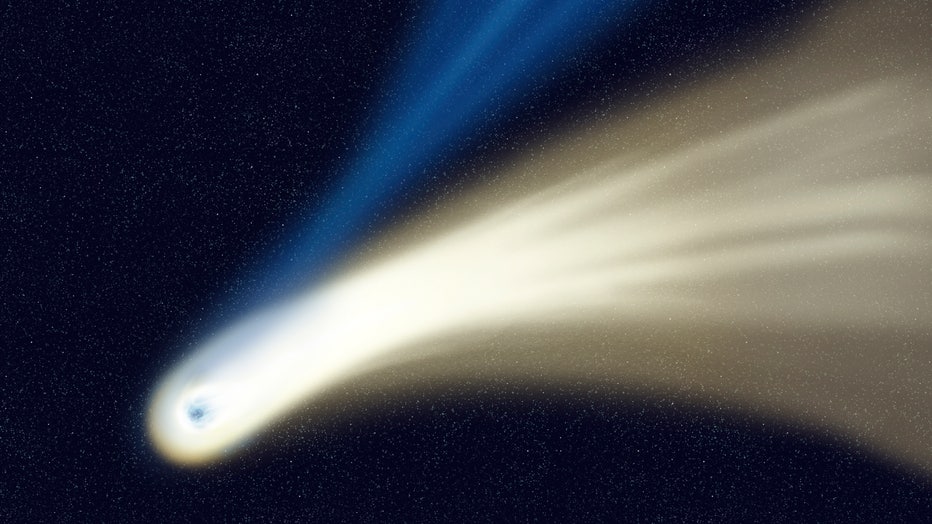'Comet of a decade' to whiz past Earth in likely first visit in 4.5 billion years

New video shows DART asteroid impact from Hubble space telescope
A video NASA released on Wednesday shows the debris caused by the Double Asteroid Redirection Test (DART) mission spacecraft slamming into the asteroid Dimorphos. (Courtesy: NASA / ESA / STScI / Jian-Yang Li (PSI) / Joseph DePasquale (STScI))
CAMBRIDGE, Mass. - A newly-discovered bright comet visible to naked eyes – even from the suburbs of larger cities – will whiz past Earth next year.
While naked-eye comets are rare, visible roughly once in two years, C/2023 A3 could be a comet of a decade, according to Peter Veres, an astronomer at the Harvard-Smithsonian Center for Astrophysics.
"Comet C/2023 A3 is no threat to Earth," said Veres, who is also a research scientist at the Minor Planet Center. "We know the comet's orbit well. The orbit is becoming better and better with more and more astrometric observations incoming to our center - the MPC."

Comet, Small icy body that partially evaporates as it approaches the Sun; made up of a head with a solid core and tails composed of gas and dust. (Photo by: QAI Publishing/Universal Images Group via Getty Images)
At closest, C/2023 A3 will be more than 70 million kilometers (43.5 million miles) from Earth on or around Oct. 12, 2024, according to Veres. At this moment, the comet is traveling at 15.7 km/s (35,120 mph) and accelerating.
"At the closest point to the sun, at the perihelion, it will be moving at 67 km/s (149,900 mph)," he adds. "Comets on parabolic orbits are very fast in comparison to the planets or asteroids with orbits of near-circular or mildly elliptical shapes."
Currently, the comet is between Jupiter and Saturn and is faint, only accessible by larger telescopes. Only a coma – the nebulous envelope around the nucleus of a comet – is visible, Veres said. But once it comes closer to the sun, the sublimation of ices could lift more dust from its surface.
"We don't know for sure if it would survive its close approach to the sun," Veres said. "And if it does, it may be either disappointing or surprising -- if its cometary activity becomes hyperactive."
LARGEST COMET EVER SPOTTED SEEN BARRELING THROUGH OUR SOLAR SYSTEM

Green Comet flies close to Earth for first time in 50,000 years
Footage posted by Matt Graves on January 28 shows the green comet in the sky as it made its approach towards Earth. (Credit: Matt Graves via Storyful)
When was comet C/2023 A3 first reported?
The comet was first reported as an unknown object to MPC on its Near-Earth Object Confirmation page on Jan 9. Veres said the observations came from the Purple Mountain Observatory in China.
"However, nobody else was able to observe the object on the following nights, thus, it was removed from the confirmation page," he said.
Almost two weeks later, on Jan 22, another telescope (NASA-funded ATLAS South Africa) reported the same object. Not knowing it belonged to the Purple Mountain's discovery, the object was again posted to NEOCP.
"This time, there was a lot of follow-up from many telescopes and thus MPC was able to compute its orbit. The orbit was parabolic and highly inclined to the ecliptic, thus everything pointed out to the fact this might be a comet," Veres said.
The International Astronomical Union eventually decided to name the comet, giving the credit to Purple Mountain and ATLAS, and MPC announced its orbit and designation as C/2023 A3 (Tsuchinshan–ATLAS).
According to Veres, it seems like this could be the comet's first visit to the inner solar system since it was created 4.5 billion years ago and thrown into the abyss of the Oort cloud.
"It will be the closest to the Sun late in September 2024, two weeks later, it will reach its closest point to the Earth," he added.
EVERYTHING SCIENTISTS WOULD WANT TO KNOW IF AN ASTEROID WAS HEADING TOWARD EARTH
Is it similar to the recent 'green comet'?
There is a similarity between C/2023 A3 and the recent green comet C/2022 E3 (ZTF), which reached its closest approach to the sun on Jan. 12. The comet was seen by people on Earth with the help of telescopes and binoculars.
Veres said both are comets from the Oort cloud, coming to the solar system from its largest distances on nearly parabolic and highly inclined orbits. However, C/2023 A3 seems to be larger.
"Comets are unpredictable, and this can't be more true for the comet that is being seen for the first time," Veres said.

